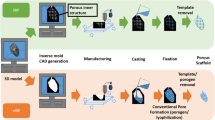Abstract
Scaffolds are of great importance for tissue engineering because they enable the production of functional living implants out of cells obtained from cell culture. These scaffolds require individual external shape and well defined internal structure with interconnected porosity. The problem of the fabrication of prototypes from computer assisted design (CAD) data is well known in automotive industry. Rapid prototyping (RP) techniques are able to produce such parts. Some RP techniques exist for hard tissue implants. Soft tissue scaffolds need a hydrogel material. No biofunctional and cell compatible processing for hydrogels exists in the area of RP. Therefore, a new rapid prototyping (RP) technology was developed at the Freiburg Materials Research Center to meet the demands for desktop fabrication of hydrogels. A key feature of this RP technology is the three-dimensional dispensing of liquids and pastes in liquid media. The porosity of the scaffold is calculated and an example of the data conversion from a volume model to the plotting path control is demonstrated. The versatile applications of the new hydrogel scaffolds are discussed, including especially its potential for tissue engineering.
Similar content being viewed by others
References
G. B. STARK, R. HORCH and E. TANCZOS, “Biological Matrices and Tissue Reconstruction” (Springer, Berlin, 1998).
T. WOHLERS, Wohlers Report 2000, Wohlers Associates, Inc. Fort Collins, Colorado, 2000.
E. SACHS, M. CIMA, P. WILLIAMS, D. BRANCAZIO and J. CORNIE, Journal of Engineering for Industry 144 (1992) 481.
R. A. GIORDANO, B. M. WU, S. W. BORLAND, L. G. CIMA, E. M. SACHS and M. J. CIMA, J. Biomater. Sci. Polymer Edn. 8(1) (1996) 63.
D. W. HUTMACHER, T. SCHANTZ, I. ZEIN et al., J. Biomed Mater. Res. 55(2) (2001) 203.
D. W. HUTMACHER, Biomaterials 21(24) (2000) 2529.
K. Y. LEE and D. J. MOONEY, Chemical Reviews 101(7) (2001) 1869.
W. M. KÜUHTREIBER, R. P. LANZA and W. L. CHICK, “Cell Encapsulation Technology and Therapeutics” (Birkhäuser, Boston, 1998).
R. LANDERS, U. H ÜBNER, R. SCHMELZEISEN and R. MÜLHAUPT, Biomaterials, submitted.
R. LANDERS and R. MÜLHAUPT, Macromol. Mater. Eng. 282 (2000) 17.
Author information
Authors and Affiliations
Corresponding author
Rights and permissions
About this article
Cite this article
Landers, R., Pfister, A., Hübner, U. et al. Fabrication of soft tissue engineering scaffolds by means of rapid prototyping techniques. Journal of Materials Science 37, 3107–3116 (2002). https://doi.org/10.1023/A:1016189724389
Issue Date:
DOI: https://doi.org/10.1023/A:1016189724389




